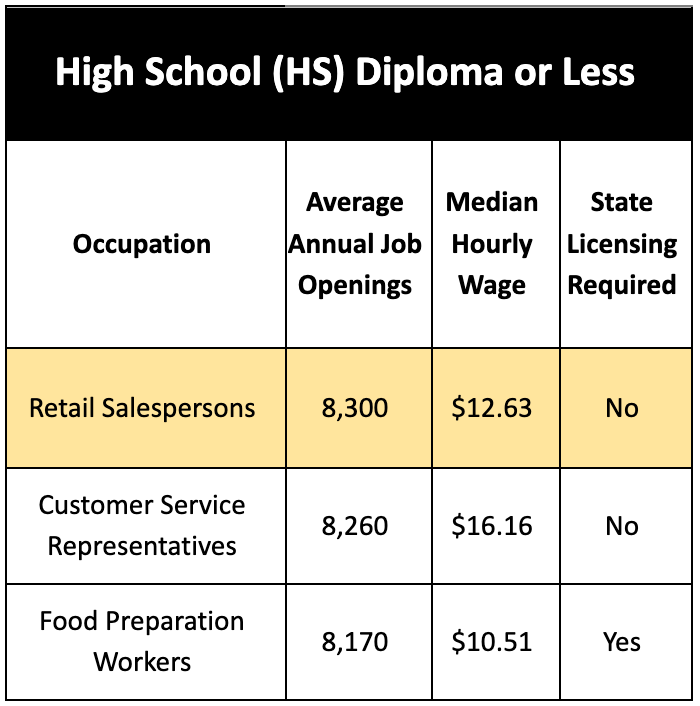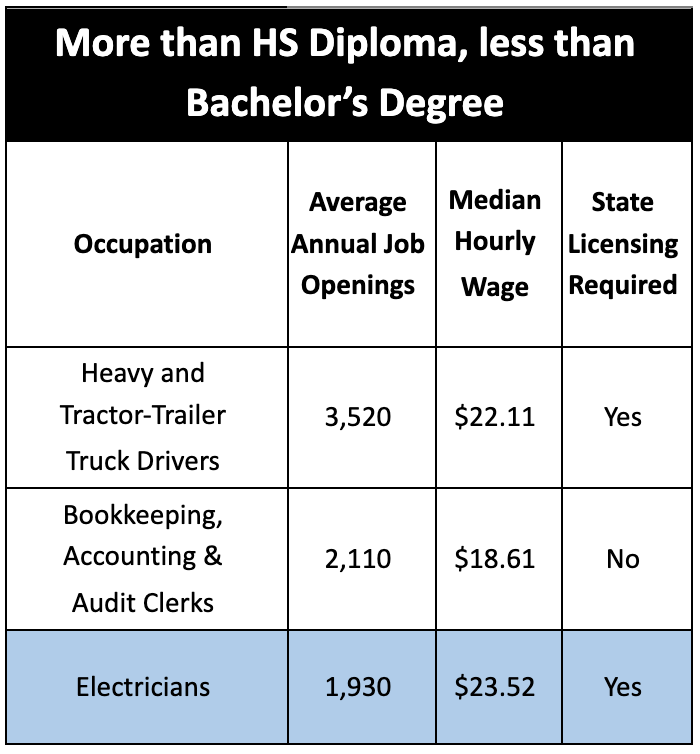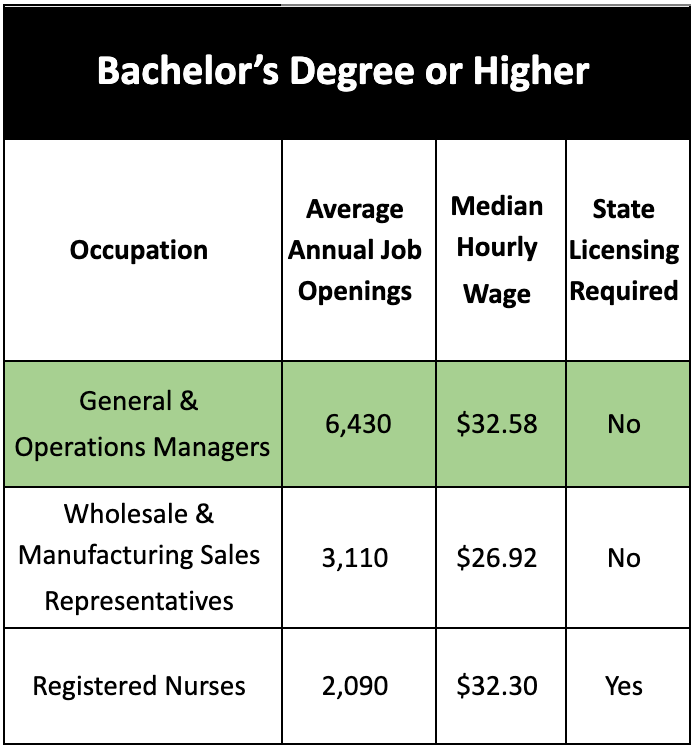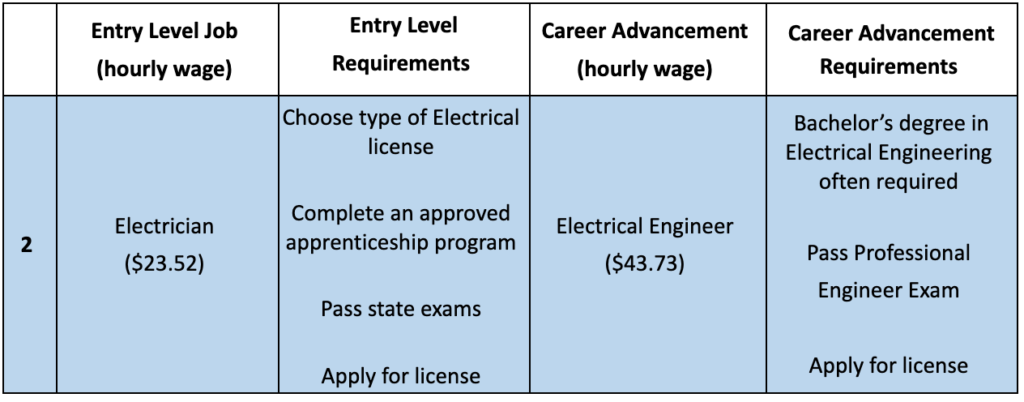Job Shortages
The tables below show the top three occupations that are projected from 2018-2028 of Utah employers based on the level of education they require. There is a state minimum wage of $7.25 in Utah. The one highlighted occupation under each of the three education levels has been selected to expand on in terms of potential career advancement.



Potential Career Advancement
1) Retail Salesperson to Supervisor of Retail Sales Workers

Retail Salesperson Job Description:
- Sell merchandise, such as furniture, motor vehicles, appliances, or apparel to consumers
Entry Level Requirements:
- Short-term, on-the-job training
- English language proficiency
Supervisor of Retail Sales Workers Job Description:
- Supervise and coordinate activities of retail sales workers in a department
Career Advancement Requirements:
- High school diploma or GED typically required
2) Electrician to Electrical Engineer

Electrician Job Description:
- Install, maintain, and repair electrical wiring, equipment, and fixtures
Entry Level Requirements:
- Choose which type of Electrical license you wish to obtain: (1) Journeyman Electrician can work on a wide range of job sites, including commercial and industrial, (2) Residential Journeyman Electrician is limited to residential work, (3) Master Electrician can plan and supervise a complex project
- Complete an approved apprenticeship program and accumulate on-the-job hours
- Pass the Utah Electrical Licensing Theory, Code, and Practical Examinations
- Apply for license with state of Utah
Electrical Engineer Job Description:
- Research, design, develop, test, or supervise the manufacturing and installation of electrical equipment, components, or systems for commercial, industrial, military, or scientific use
Career Advancement Requirements:
- Bachelor’s degree in Electrical Engineering often required
- Pass the Professional Engineer exam
- Apply for Professional Engineer license with state of Utah
3) General & Operations Manager to Chief Executive

General & Operations Manager Job Description:
- Plan, direct, or coordinate the operations of public or private sector organizations, overseeing multiple departments or locations
Entry Level Requirements:
- Bachelor’s degree in Business related field
- Prior experience in managerial position often required, more information found here
Chief Executive Job Description:
- Determine and formulate policies and provide overall direction of companies or private and public sector organizations within guidelines set up by a board of directors or similar governing body
Career Advancement Requirements:
- Bachelor’s degree in Business related field, MBA encouraged
- 5+ years of management experience, more information found here
Immigration in Utah
The following are facts about the immigrant community in Utah:
- Immigrants comprise 9% of the state population and 11% of the Utah labor force
- Top industries of immigrant employment:
- Manufacturing, 31,148 workers
- Construction, 24,707 workers
- Accommodation and Food Services, 21,605 workers
- Health Care and Social Assistance, 19,173 workers
- Retail Trade, 16,735 workers
- 16,852 immigrant business owners account for 11% of all self-employed Utah residents
- 41% of immigrants in Utah are naturalized and another 38% are undocumented
- Top foreign-born countries of origin:
- Mexico, 35%
- India, 4%
- Venezuela, 4%
- Peru, 4%
- Canada, 3%
- 9% of native-born Utahns are children of an immigrant
- Educational attainment of foreign born adults in Utah:
- High School diploma or less – 51%
- More than HS diploma, less than Bachelor’s degree – 22%
- Bachelor’s degree or higher – 27%
- Share of Brain Waste* – 33%
* Share of immigrant professionals, who are unemployed, employed at poverty-level wages in High School diploma or less jobs, or significantly underemployed in more than HS diploma, less than Bachelor’s degree jobs
Sources
Jobs
Projections Managing Partnership (PMP), Projections Central – State Occupational Projections, “Long Term Occupational Projection (2018-2028)”; http://www.projectionscentral.com/Projections/LongTerm
Bureau of Labor Statistics, May 2019 State Occupational Employment and Wage Estimates; https://www.bls.gov/oes/current/oessrcst.htm
Bureau of Labor Statistics, Employment Projections, “Education and training assignments by detailed occupation,” 2019; https://www.bls.gov/emp/tables/education-and-training-by-occupation.htm
National Council of State Legislatures, “State Minimum Wages”, December 2020; http://www.ncsl.org/research/labor-and-employment/state-minimum-wage-chart.aspx#Table
Bureau of Labor Statistics, Economic News Release, “Employees on Nonfarm Payrolls by State, Seasonally adjusted”, November 2020; https://www.bls.gov/news.release/laus.t03.htm
Potential Career Advancement
National Conference of State Legislatures, “The National Occupational Licensing Database”, March 2020: https://www.ncsl.org/research/labor-and-employment/occupational-licensing-statute-database.aspx
Immigration
American Immigration Council, State by State Fact Sheet, August 2020; https://www.americanimmigrationcouncil.org/topics/state-by-state






